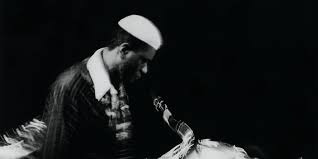Ming Smith at the MoMA: A Sensory Experience of Jazz and Black Life
Ming Smith’s photograph, Pharaoh Sanders at The Bottom Line (1977) captures both a meaningful image of a musician in his element and the essence of jazz itself.
Sanders is pictured in high contrast against a primarily black background with no other identifiable elements in the scene. He is in the middle of a performance, his eyes downcast on his instrument as he is about to return it to his lips. Smith uses this moment to draw the viewer into the sounds of the scene itself. Smith captures Sanders’ body, shifting from left to right with his saxophone. The viewer can see Sanders guided by the rhythms of the music, letting them carry him through his performance. His face, however, remains still and focused, possibly as he takes in a deep breath. Against the black background, the world disappears around Sanders, and the viewer is left to focus on him alone. This also creates a captivating contrast, the black background and Sander’s white hat, which work to convey a sense of edgy, strong energy.

Smith’s image pulls the viewer into the scene, evoking the same emotions an audience member might feel at a live performance of the song titled, Thembi. Although the image is black and white, the song Thembi brings life to our ears and helps us to color the image of Sanders’ as he plays. Both viewer and listener are hyper-focused on Sanders alone, at the edge of their seat awaiting the break of his deep saxophone against the rhythms of the band behind him.
Smith manages to replicate an intimate, one-on-one musical experience without the use of any sound. Instead of sound, Smith relies on movement to evoke a sense of rhythm. Sanders’ slightly blurred body and saxophone are swaying to the music, carrying the viewer along. The instruments in the background are also blurred in the same pattern simulating quick movement, possibly in tribute to the quick and free sounds of Thembi. This creates another element of intimacy for the viewer to share a moment with the musician. Smith’s reliance on movement and focus truly draws us into Sanders’ world. For a brief moment, we are transported back to the dimly lit jazz bars of 1970s New York City.
Post a comment